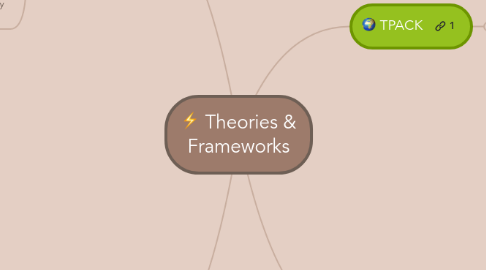
1. SAMR
1.1. How teachers use technology in the classroom
1.2. There are four levels in this model: Substitution, augmentation, modification, and redefinition.
1.3. Outlines how effective it is to integrate different forms of technology in different tasks. Sometimes technology can be more useful than others.
1.4. Integrates the four levels of TPACK.
1.5. The goal is to bring students from technology enhancement to technology transformation.
1.5.1. Enhancement
1.5.1.1. Substitution: Using technology to perform a task that could be down without technology as well. There is no functional change, technology is just substituting something else.
1.5.1.2. Augmentation: Using technology to complete a task that can be done without technology. In this case, the technology is improving the function of the task. Students can receive immediate feedback, paper is saved, etc.
1.5.2. Transformation
1.5.2.1. Modification: Using technology allows the task to be completely redesigned. Technology is necessary for these tasks to be completed in this way.
1.5.2.2. Redefinition: Using technology allows students to partake in activities that were never possible before. These tasks would not exist without technology! Increasingly student generated.
2. 21st Century Learning
2.1. 3 levels of knowledge for the 21st century learner
2.1.1. Foundational Knowledge
2.1.1.1. Core Content: Using different knowledge and ways of thinking to understand the world.
2.1.1.2. Digital and Information Literacy: Using technology to function in a digital world.
2.1.1.3. Cross-disaplinary: Integrating information across different fields.
2.1.2. Meta Knowledge
2.1.2.1. Problem Solving and Critical Thinking: Interpret and make decisions based on information.
2.1.2.2. Communication and Collaboration: Communicate through media, be an active and respectful listener.
2.1.2.3. Creativity: Evaluate, elaborate, and define ideas.
2.1.3. Humanistic Knowledge
2.1.3.1. Life and Job Skills: Manage, ordanize, and coordinate information.
2.1.3.2. Cultural Competence: Communicate, collaborate, and appreciate ideas from all different types of individuals.
2.1.3.3. Ethical and Emotional Awareness: Deep understanding and respect of human emotions.
3. TPACK
3.1. Technologocal Pedagogical Content Knowledge
3.2. 3 primary forms of knowledge
3.2.1. Technological Knowledge
3.2.1.1. Knowledge of the different technology tools that can be integrated into teaching. Teachers must understand which tools are easy enough for students to use, and which tools will further students' learning more than distract them.
3.2.2. Pedagogical Knowledge
3.2.2.1. Knowledge about how to teach. The teacher must know whether the tasks are suited to the learner.
3.2.3. Content Knowledge
3.2.3.1. Knowledge of the content itself. The teacher must make sure that the students have all of the content and information that they need!
3.3. TPACK helps teaching integrate technology into the classroom.
3.4. Technology, pedagogy, and content are all important. Teachers must collaborate this 3 areas of knowledge.
3.5. This link leads to articles and diagrams demonstrating the interconnectedness of TPACK.
4. Philosophy of Teachnology
4.1. A combination of the philosophy of teaching, and the use of technology in the classroom.
4.1.1. In addition to just in the classroom, P.o.T. can include online learning and professional development.

